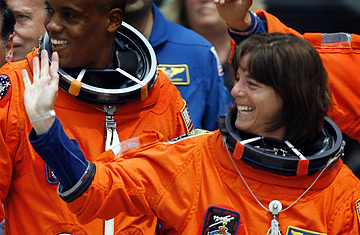
Space Shuttle Endeavour astronaut and former teacher Barbara R. Morgan departs the Operations and Checkout Building at Kennedy Space Center en route to the space shuttle August 8, 2007 at Cape Canaveral, Florida.
Think Americans stuck in airports have to wait a long time for a flight? Try 22 years. That's how long astronaut Barbara Morgan, 55 — who blasted off Wednesday aboard the shuttle Endeavour for a planned 11-day mission — had to cool her heels before she got her first chance to fly.
Chosen as the backup to the original teacher-in-space, Christa McAuliffe, in 1985, Morgan was on site at Cape Canaveral the following year when McAuliffe and her six crewmates perished in the explosion of the shuttle Challenger. The fact that she's now in space is a tribute to her tenacity — to say nothing of her courage — as well as to NASA's often artful ability to include a compelling storyline in what would otherwise be a routine space flight. What it says less about — as is so often the case with the NASA of the last generation — is the value of the shuttles themselves and the current state of the manned space program.
The Teacher in Space program was a creature of NASA's arguably naive, 1980s belief that, with a fleet of sturdy shuttles, space flight could become a wonderfully routine thing. Former Utah Senator Jake Garn snagged himself a seat on one flight — never mind that he spent much of the mission so violently space sick that NASA wags informally added a whole new category, labeled "Garn," to the sliding scale used for diagnosing nausea in orbit. Then Congressman (now Senator) Bill Nelson of Florida spent six days in space aboard the shuttle Columbia in January of 1986, the same month Challenger blew up, causing NASA to decide that maybe space flight was a risky enough job that it indeed ought best be left to the professionals.
Morgan nonetheless stayed with the agency, serving as a roving ambassador for space flight and remaining, in name at least, a Teacher in Space designee. Under NASA's newer, stricter flight eligibility rules, however, the only way she could ever get her chance to fly would be to quit the teaching profession and become a professional astronaut, relegating kids' education from space to a much more incidental part of her responsibilities. She applied for a slot and in 1998 was selected; she is now flying as a mission specialist, responsible for operating the robotic arm of both the shuttle and the International Space Station (ISS), with which the crew will be docking.
Sounds like a success story, and in some ways it is. But in the service of what? This is the 119th flight of a space shuttle, the 20th for Endeavour and the 22nd overall to the ISS, a still-growing orbiting outpost that is more or less the only reason any of the shuttles fly anymore. The Endeavour crew will be delivering a two-ton truss segment that will help hold solar arrays and will require three risky spacewalks to install. If the ISS were doing good science at an arguably reasonable price, those risks would be worth taking. But it's doing almost no science at all at an exorbitant price — an estimated $100 billion a year — and will have no shuttles left to service it in 2010 when the shuttle fleet is scheduled to retire. NASA has been promising big payoffs from the ISS — advances in biomedical research, for example, and in materials manufacturing — since President Ronald Reagan first proposed it in 1984, and has never been able to deliver. Meanwhile, the shuttle Columbia claimed the lives of another seven astronauts in 2003, a disaster Morgan was once again on hand to witness, this time as capsule communicator, in Mission Control.
Yesterday's launch included plenty of respectful grace notes. Sixty of the 114 candidates for the Teacher in Space slot in 1985 were at the liftoff, as were a number of relatives of the astronauts lost in the 1986 explosion. NASA was almost defensive in insisting that Endeavour is a sound ship, pointing out that in the nearly five years since it last flew it's undergone improvements so extensive as to leave it almost unrecognizable. "It's like a new space shuttle," shuttle program manager N. Wayne Hale told a news conference.
The astronauts seemed to feel the need to argue for the mission too. "This is serious business we're in here," shuttle commander Scott Kelly radioed shortly before liftoff, as if spacewatchers needed to be reminded of that fact.
Morgan, meantime, will fulfill McAuliffe's legacy, if in a slightly new capacity. No longer a Teacher in Space, but now an "Educator Astronaut," she will teach at least one live lesson from orbit, and up to two more if the mission is extended from 11 to 14 days, as it might be. She is also carrying a cargo of 10 million cinnamon basil seeds (a figure she playfully rounds up to "a kazillion,"), which will be distributed to schoolchildren to grow post-flight, so that they can observe any anomalies that might be attributable to the stint in weightlessness.
All of these things are what educators call teachable moments — a valuable and elusive commodity in the profession that only the best teachers and students know how to exploit fully. The folks at NASA have had two tragic teachable moments of their own — in 1986 and 2003. So far, they don't seem to have learned much.
